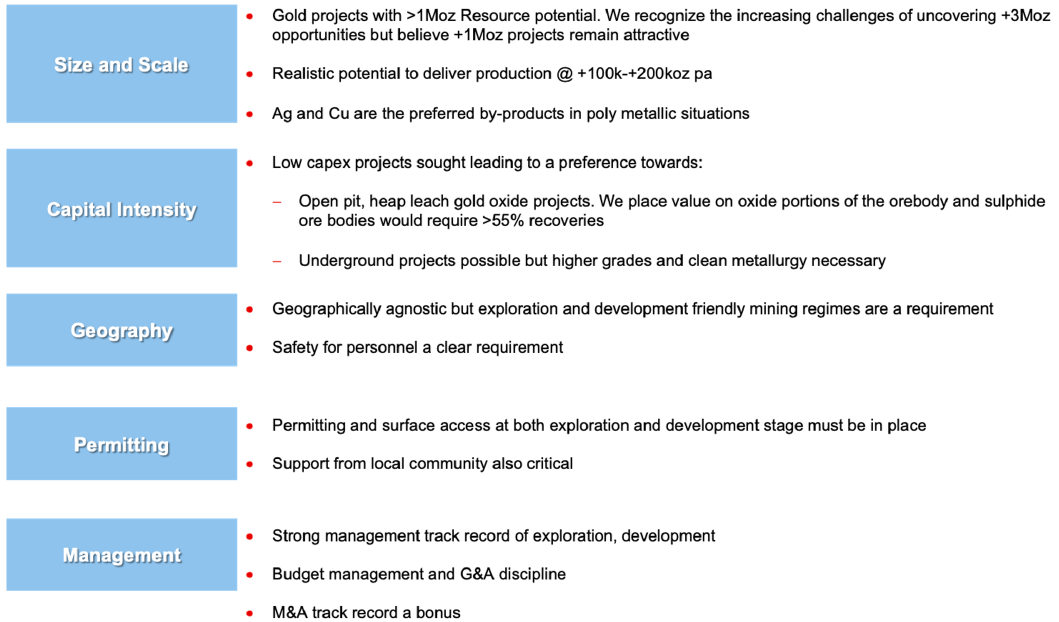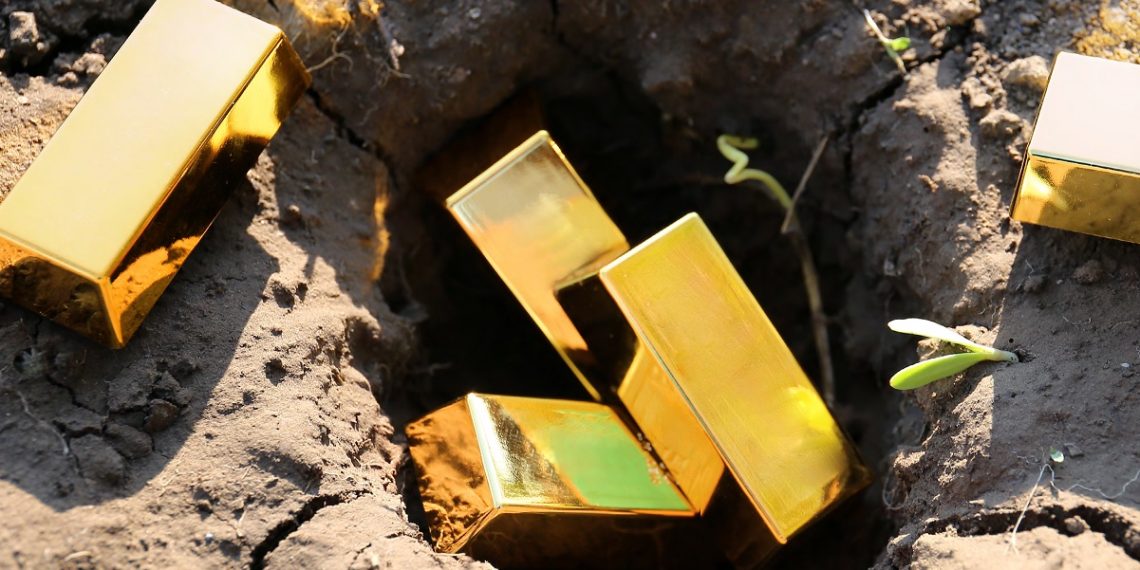Can you provide insight into the investment approaches of the fund you manage? How do miners meet investment criteria?
We aim to adopt a highly systematic approach for reviewing investment opportunities, ranging from a geological and engineering review of assets, through to valuation and understanding management strategy.
In principle, we seek to support the discovery and/or development of scale systems where extraction is possible, with reasonable capital intensity. A technically driven approach is adopted to screen for economic grades, clean metallurgy, and amenability to simple mining and processing methods.
Management teams that exhibit strong governance (both corporate and ESG) practices and capital discipline are also factors for consideration. As an overlay, we also review opportunities through the lens of potential M&A and other event driven special situations — and as such, seek to evaluate the potential attractiveness of properties to mid-cap and large-cap business development teams.
I’ve outlined below some of the granular criteria we examine. Concededly, this is just a generic high-level guide (and there is never a perfect situation), but it broadly captures the issues to consider when performing due diligence on potential investments.
We are generally very flexible in terms of how we make our investments. Depending on the situation, we can invest at all levels of the capital structure (prefs, ordinary, debt, convertibles, etc.) We have also, in the past, sub-underwritten issuances.
The gold price has been bullish this year so far. What are the drivers for this?
A range of factors this year have contributed to a bullish gold price environment. In my view, the current gold price buoyancy has been boosted by several key macro factors, including nervousness around a negative US dollar trajectory, recession risk globally (hard or soft), expectations for lower future interest rates, elevated geopolitical risk amidst the ongoing Ukraine conflict, and persistently high inflation.
Also, recall the period of bank instability at the start of the year, which saw the failure of Silicon Valley Bank and Credit Suisse AG, which at the time, saw a spike in gold price — signaling the desire for short term safe haven purchasing.
Commentators also point towards other factors, such as elevated jewellery demand post-COVID, retail investment in gold bars and coins as a means of wealth protection, and of course, central bank buying led by China, India, and the Middle East.

Where do you think the price of precious metals will go in H2 2023, into 2024?
Overall, I expect the gold price to trend higher than current levels.
Compared to 2022, broker analysts’ consensus price forecasts point towards more gains in 2023 — a quick review of the London Bullion Market Association (LBMA) gold analyst forecasts and Bloomberg screens indicate that a majority of analysts had price increase forecasts for 2023.
However, despite strong fundamentals in recent months, there still appears to have been very minimal generalist buying. If we compare the year-on-year gold ETF flows, we are nowhere near the net in-flows we saw in 2020, when the gold price hit its then record highs of about US$2,080/oz.
I believe that the beginning of generalist buying would mark the start of a meaningful re-rate in the gold price. Timing is unclear, but multiple catalysts could spark this buying ranging from geo-political risks, through to macroeconomic downside in the US, European, and Chinese economies.
How has silver compared to gold this year? Do you think silver will continue to outperform gold?
The gold/silver ratio is still stubbornly high. Over the last decade, it has moved from about 30-1, up to around 120-1, and is now hovering around 85-1.
The market accepts that silver is a quasi-precious/quasi-industrial metal with different drivers to gold. If one accepts the narrative that we are approaching a period of global economic contraction, then we should see relative underperformance vis-à-vis the gold price. As such, I wouldn’t be surprised if the gold/silver ratio moves towards 100-1 in the near term.
In the long term however, silver’s application in solar panels and its positive correlation to Chinese industrial growth may well see the silver price re-approach it’s decade high of nearly US$50/oz.
How will the discourse around the energy transition and decarbonization affect the outlook for precious metals?
There is no doubt that the discourse around energy transition and decarbonization will have a material impact on gold miners, and by extension, precious metals. As gold production continues to expand, the operational challenges of gold miners to continue to produce, steadily increase — whether it is by virtue of grade degradation, deeper mines, or a need to venture into more remote territories globally. As such, total energy consumption (as estimated by the World Gold Council) has increased by over 25% in the past five years alone. If gold miners are to contribute towards decarbonization and be part of the energy transition narrative, a great deal of change by way of operational solutioning will be required. Moving towards a lower carbon power source and the utilization of renewables has been announced by several miners, but for such initiatives to be broadly adopted across the industry, pressure on margins, and thus challenges in growing production may well eventuate.
In any case, the industry’s move towards decarbonization is still at its relative infancy and I expect to see more developments on these issues over the next several years.
How can investors integrate ESG into their precious metals investment decisions?
There are often challenges observed from investors who, upon first glance, regard mining as being environmentally disruptive/harmful, and therefore inconsistent with their mandate parameters. The gold mining industry is cognizant and has made gradual improvements to its ESG credentials over time. As a set of industry standards, the World Gold Council’s Responsible Gold Mining Principles calls for compliance by members on several ESG related fronts, ranging from environmental management and community engagement, through to labour equality. Going forward, it is expected that many gold explorers, developers, and producers will increasingly align their ESG policies to be consistent with the World Gold Council’s framework.
Furthermore, it is anticipated that our investors will increasingly demand that we (and funds alike) continue to scrutinize ESG-related issues as part of the investment screening process.
What are some of the most exciting precious metals jurisdictions at the moment? Are there any emerging regions?
Naturally, forming a view on sovereign risk forms part of the investment process. While we seek to construct and maintain a geographically balanced portfolio, we are comfortable with being overweight in jurisdictions where we see a favourable risk and reward proposition.
Since inception, we have seen success in West Africa, where our fund has historically taken meaningful exposure to jurisdictions, such as Cote d’Ivoire and Guinea. I continue to believe the risk/reward proposition at current valuations remains attractive in many parts of the African continent currently. Similarly, under the radar gold systems in various jurisdictions across Southeast Asia and the Asia Pacific could become interesting in the medium term, once gold sentiment definitively turns and competition for assets escalates.
I continue to believe the risk/reward proposition at current valuations remains attractive in many parts of the African continent currently
In the near term, low-risk sovereign exposure to well-established mining camps in Canada and Australia could be the early beneficiaries of buying demand once generalist funds rotate into safe-haven gold exposure. This view has been validated by a number of recent M&A deals announced involving Canadian and Australian companies.
Do you have any thoughts on what mining companies should be doing to make their companies attractive to investors?
This question is a difficult one to answer as different investors inevitably focus on different things. We focus on technical progression, whereas others may want to see more M&A posturing, etc.
Based on our style of investing, we have had positive experiences with management teams that have been open to periodic dialogue with us. A quick coffee at a conference, or even a 30-minute call to update us on what has been going well (and not so well), has been helpful in both managing our portfolio and committing to new investments.












